Introduction
In this article, I will relate the ancient Indian teaching on the three gunas to energy qualities that are expressed in the human psyche, or brain-mind. Some examples will be given that can be of therapeutic use.
Also, I will present some cybernetic diagrams of the perception-feeling-emotion process action-loop that tie in with the idea of the gunas. Much is still to discover about said process, and these diagrams are just a first step in gaining more understanding of it.
The three gunas
The three gunas are: sattva, rajas, tamas. Briefly stated, sattva designates balanced use of energy, rajas means activity and tamas passivity or inertia. There is a deeper explanation of these gunas which is not well-known. It has to do with the simultaneous working of these qualities, and their relative dominance. For example: pure tamas (tamas in the tamas condition) can be equated with passivity in a negative sense. However, tamas can be in a higher condition (sattvic, balanced) which equates with persistence and steadfastness, which have a positive connotation. The same applies to rajas: pure rajas is uncontrolled, raw energy, while controlled rajas (in a sattvic condition) is an expression of wise use of observing ability plus well-directed energy. This explanation is rarely given in standard texts. Yet, it makes much sense, as you will see when studying the following diagrams.
Fig. 1: polarities and the gunas.
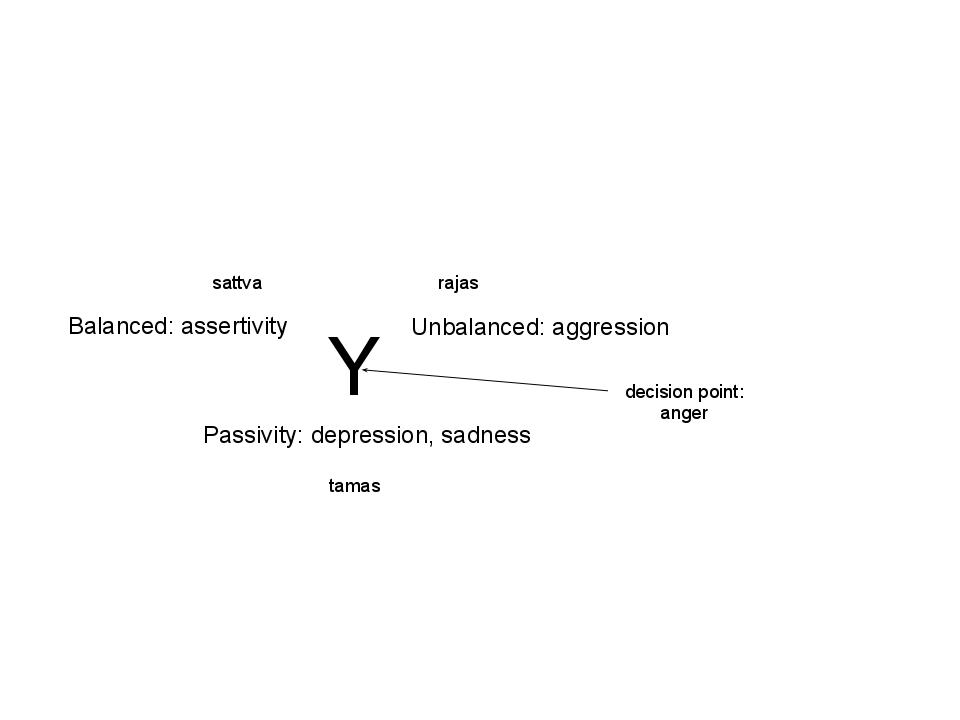
Explanation of fig. 1.
The process starts at the decision point. This simply is a state of mind, brought about by some psychic energy, as you will see in the next figures. It can be anger, or jealousy, or fear, or any other activation of an emotional state of the mind. This state calls for some resolution, some action, some decision or choice to be made.
The balanced approach, a constructive decision, requires some observational ability.
It is something that may take longer to do, or may require more patience, than the unbalanced approach which is often destructive or missing the mark.
There also is a possibility that one does not choose to do anything at all. One remains passive, which usually means that one ends up being controlled by one's instincts and impulses, or at the mercy of the environment and other people.
To make this a bit clearer, let's have a look at some concrete examples of psychological energies at work. See figs. 2, 3, 4.
Fig. 2: How anger is resolved.
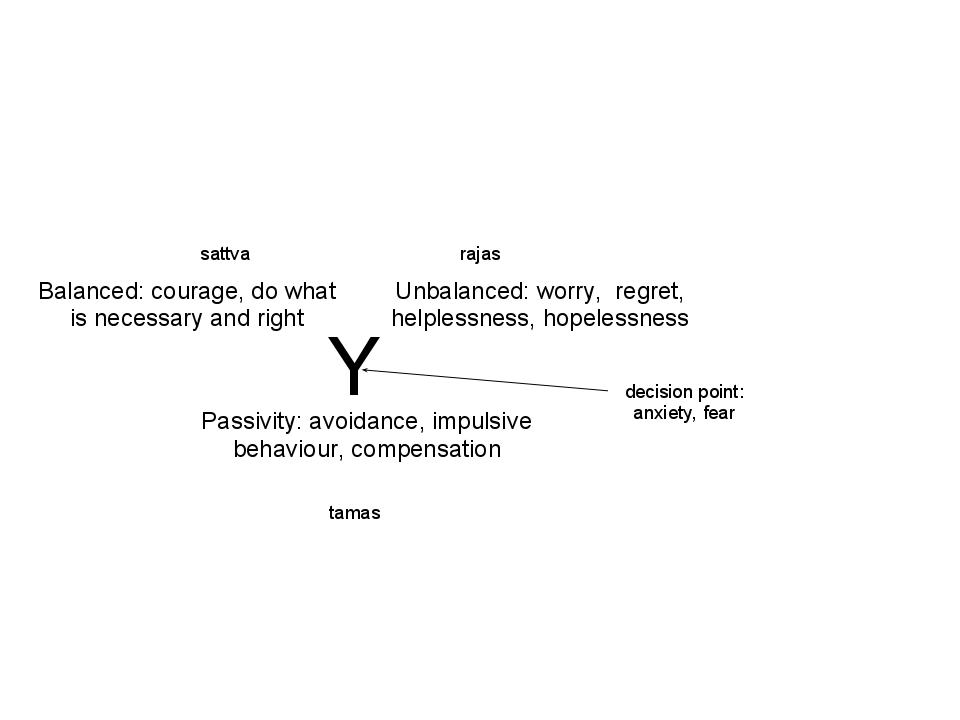
Explanation of fig. 2.
Anger is seen here as a signal of the psyche (from the subconscious to the conscious) that something is not well. Typically, some kind of hurt from outside impinges on one's boundary. It can be something that someone says to you, or an unpleasant look or gesture.
Anger is not a negative energy. It is a neutral energy, which function it is to alert you to some hurt, or a signal that some need is not met.
The mature reaction to anger is to assert your needs, and to assert your boundary. Stating that you don't like something someone just said to you is a mature thing to do.
(If it doesn't touch you, then you probably will just ignore the message.) Being able to say no, is a mature thing too. And being able to hear no, is a mature thing as well. Aggression, in the modern use of the word, means an inappropriate use of energy. It almost always leads to hurting another person. Most likely, the other will try to retaliate, which may lead to a vicious cycle of verbal and/or physical violence. Not a healthy situation.
There is also the possibility that one does not make a choice in dealing actively with the signal that the subconscious is giving you (as the conscious operator or ego). This will result in a state of depression or feelings of sadness. This is needless suffering, and one will remain in this state until the lesson, implicit in the situation, is learned.
Another example of psychological energies at work is given in fig. 3: the resolution of fear
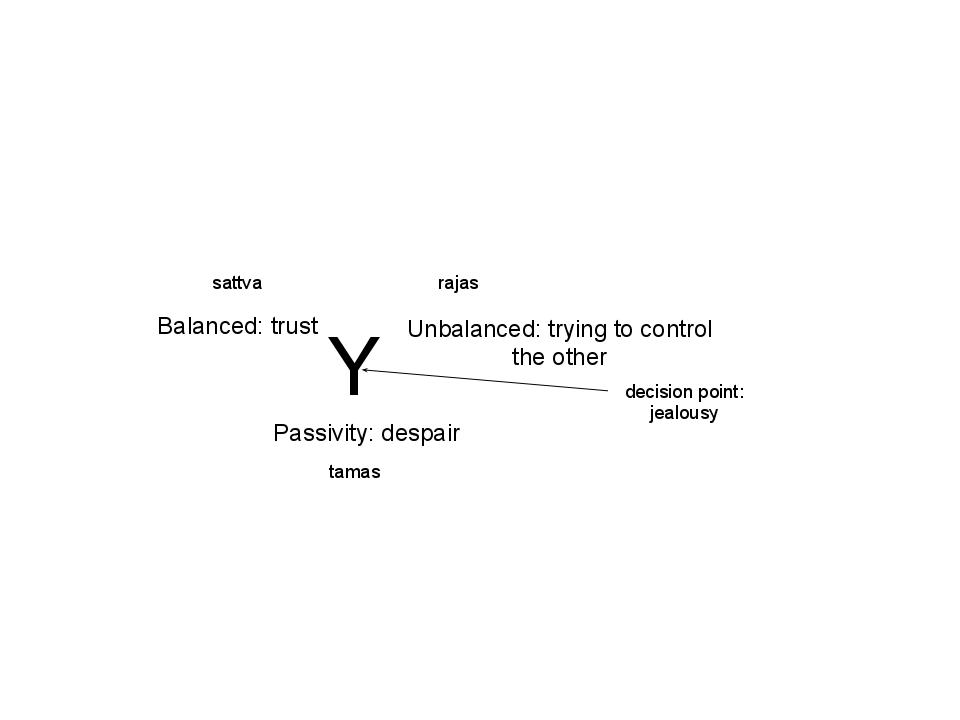
Explanation of fig. 3.
Here, the signal is fear or a state of anxiety. The only positive resolution of this state is to do what is needed (and right), in a given situation. One can call this courage, without the association of a knight going to war. Fears can be many: fear of losing one's job, fear of losing one's partner (see next figure), fear of contracting a disease, etc.
Dealing constructively with fear requires to face the situation one is in with an open, observing mind. See the possibilities that are open to you at any moment in time, and weigh your options. It does not help to keep worrying about what could happen to you. It is a waste of valuable energy and leads to suffering. Another option is to put your head into the sand, like an ostrich, and avoid any consideration of options. It is more than likely that you will regress into compensatory behavior: overeating, addictions to alcohol, work, drugs. Panic may set in too.
Another example is given in fig. 4: resolution of jealousy
Explanation of fig. 4.
By now, you may have got an inkling of how various psychological energies are related to decision making. There is a balanced way to do things, an unbalanced way (missing the mark) and a passive attitude, which leads to suffering, like the unbalanced way. In the case of jealousy, let's say about a partner, or potential partner, who you see in company with someone of the opposite sex (or same sex, if you are gay or lesbian), there are choices you can make. The balanced way is to trust the other person. That is: you realize that you don't possess the other. You cannot decide what is right for the other.
How could you? The other has a right to lead his or her own life. You may be a part of it, or you may not. If you think otherwise, and try to control the other, say by forcing him or her to stay with you at home, or always trying to accompany him or her (“babysitting”), what will you accomplish? Probably the exact opposite of what you want. Grudges will arise on the part of the other and you may very well loose him or her.
When feeling jealous, fear of loosing a desired one, it will not help to stay in a passive state.
This will lead to despair. This is because you don't trust the other (your partner) and cannot engage in controlling him or her. Both are options that will not help you forward in your life. It is much better and sound to start trusting life. This attitude will give you peace of mind and is part of a positive, constructive way of dealing with situations. Using and developing your observing skills will serve you well.
Some further ideas
There are many subtle points that can be made here. I can only touch upon some here.
For example, passivity of mind should not be confused with receptivity. The latter can be a very necessary state of mind: being open to ideas, suggestions, and possibilities of a situation, etc.
A balanced use of psychological energy often requires a somewhat developed observational skill, not in the least: the skill of self-observation. It will be clear that there are mature levels of functioning and immature levels, as expressed in the diagrams. Passivity seems to me to be the least mature way of reacting, while indiscriminate use of psychological energy also classifies as immature (but will get you strong reactions from others, in this case, and you might learn a thing or two about yourself). The most mature way of decision making is the balanced way, involving good judgment, life experience, and a high moral standard.
Constructive use of psychological energies leads to self-confidence, well-being and the like. Self-esteem is associated with this. This is a matter of personal growth.
Another thing concerns the use of graphs. What I have presented here, are graphs of pathways of decision, and associated states of mind. Graphs like these can be combined.
For example, graphs of two persons who are interacting with each other can be combined.
These will portray feedback cycles. Does one reinforce co-dependency, for example? Or do two people reinforce mutual balanced growth? Interaction with the environment can be modeled likewise, giving some flow-diagrams of needs that are being met or fulfilled. The possibilities seem endless, and more research into this area is necessary.
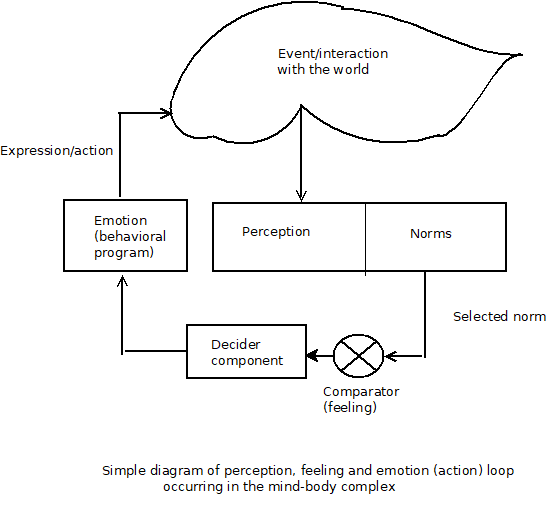
It all fits into a process philosophy and model of psychological forces at work. Perhaps the same diagrams can be used in other domains, like biology. This is an open question.
Last, but not least, my gratitude goes to Dr. Paul Dobranski, whose work on MindOs has been very helpful in developing these ideas. The work on the gunas, however, is strictly mine, and so are the diagrams in the specific form that I have given them, combining gunas with psychological energies. As you will notice, my work falls under a creative commons license, which allows other people to make use of it under the associated conditions.
Addendum
Two Cybernetic diagrams of the perception-feeling-emotion action-loop
After rereading Stafford Beer's book “The heart of enterprise”, I got the idea of drawing cybernetic diagrams of the process of perception, feeling, emotion and decision.
This is work in a beginning stage. Nevertheless, these diagrams can be helpful in understanding some of the complexities of said process.
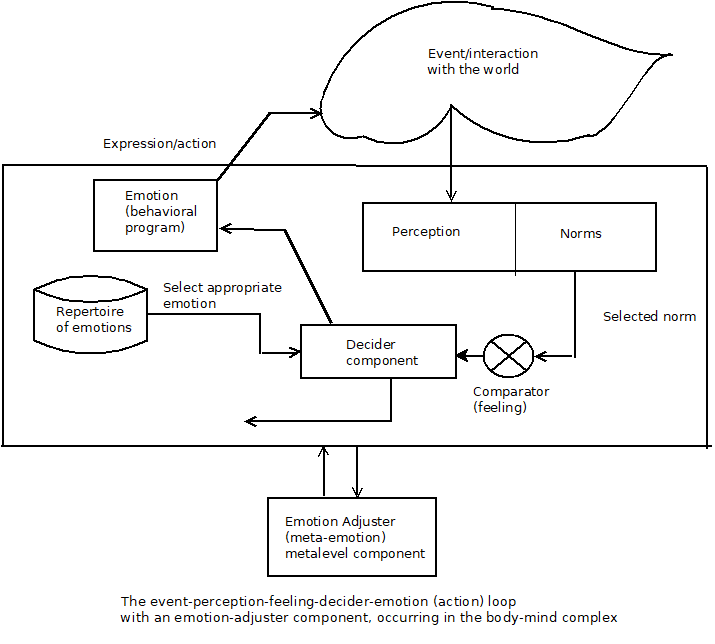
The first diagram shows how perception of an event leads to an evaluation of the significance or meaning of the event. This involves the use of a norm (mostly learned by education, nurture, etc.), necessary to compare whats happening to oneself with what is expected or deemed appropriate in a given situation. The evaluation process involves as its outcome feelings, a matter of the heart or gut, metaphorically and perhaps literally speaking.
Emotions are something else: they resemble action programs, some being instinctive, others being acquired by growing up in society. Emotions are reactions, expressions of how one feels about things. Much of this is subconscious (body language).
The decider component has to with choice, selection of an appropriate emotional response.
The following diagram shows this selection more clearly.
In this diagram is shown that an appropriate emotion is chosen from a repertoire. That should be typical for a civilized person. Now, when, on second thought (the emotion adjuster box), the emotion does not seem that adequate, the decider having been too impulsive, a correction is made to the behavior. Maybe an excuse of some sort, or a clarification of one's feeling.
There is a double line between the emotion adjuster box and the rest of the system (shown in the large box) to indicate that the adjuster works on the whole of perception, comparator and decider components. The adjuster fulfills a meta-function. It is of a higher order.
The whole system of perception, etc., is very complicated. What is shown here, is a global picture. Details have to wait until further examination.
About the author
Martin Euser received his Masters degree in Clinical Psychology and his Bachelors degree in Theoretical Physics from the Utrecht University in the Netherlands. He worked at this university as a teacher in statistics and courseware developer, and later as an internet developer at several companies. He has published many articles on esoterism, spirituality and psychology and made old texts (Jacob Boehme, Proclus) available as free ebooks in the archive.org internet archive and academia.edu. New articles of his are also published there. As a researcher on the links between science, psychology and spirit, he views cybernetics as a promising candidate for furnishing such a link.








